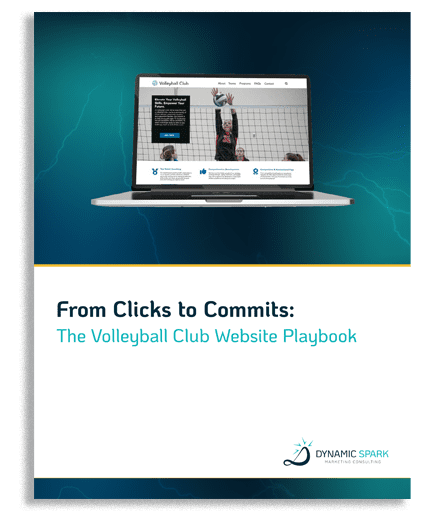
Why Your Website is Your Volleyball Club’s Best Recruiting Tool
A Parent’s Frustration Turned Into a Passion
When my daughter first told me she wanted to play club volleyball, I thought finding the right club would be simple. I’d been around volleyball my whole life, playing through high school, competing for three years in college, and even coaching for a season.
Her interest in volleyball really took off after watching the University of Wisconsin women’s volleyball team win the national championship. She was eager to play, and I was excited to help her start.
But as a parent, searching for a club was harder than I expected. Many club websites didn’t have enough information to help me compare programs. I struggled to find basic details like schedules, costs, and levels of commitment. Eventually, I signed her up for a club mostly based on location. I didn’t understand how team offers worked and missed the response window for her placement, which shaped her entire first season.
Even after coaching club for a year, I found myself asking the same questions other parents were asking me. If I was still confused, I knew parents who were brand new to the club world must be feeling the same frustration.
That’s when I realized volleyball clubs have an opportunity. Parents weren’t frustrated with the programs themselves, they were frustrated because they couldn’t get the details they needed to make informed decisions.
With over a decade of experience in marketing and website design, I decided to start Dynamic Spark to help clubs communicate better, save time, and attract the right athletes and families.
Why Websites Matter More Than You Think
Many club directors see their websites as just one of the tools they need to manage their club, but often they aren’t sure how to use them effectively. But your website is more than a digital brochure. It’s your 24/7 recruiter, communications hub, and first impression.
When a parent searches “volleyball club near me,” they aren’t just looking for dates and pricing. They are evaluating your professionalism, organization, and values. A polished, easy-to-navigate website builds trust before you ever talk to them. A confusing or outdated site, even if your program is outstanding, can unintentionally send the wrong message.
Parents are also making comparisons. When a club’s website is informative and easy to navigate, it naturally builds credibility. Your website is often the deciding factor in whether a parent reaches out or moves on.
According to a BusinessDasher’s 42+ Statistics About Websites Businesses Must Know for 2024, 75% of users judge a company’s credibility based on its website design. That means parents are forming opinions about your club within seconds of landing on your site.
Many directors worry about investing in a better site because it feels like another task on an already long to-do list. Others wonder if the expense is worth the investment, or they aren’t fully aware of technical issues that may be holding their site back from showing up in search results or competing with other clubs in the area. But your website is the one tool that works around the clock. It’s where families start their journey, and it’s often where they decide whether your club feels like the right fit.
A Strategic Approach to Volleyball Club Websites
The good news is, you don’t need a massive overhaul to see a big difference. By focusing on clarity, organization, and trust, your club can stand out without overwhelming you or your budget. Below are essentials every volleyball club website needs to educate parents, save time, and help you recruit the athletes who are the best fit for your program.
Essentials Every Volleyball Club Website Needs
- Your Club’s “Why” Front and Center
Parents want to know what your club stands for. Beyond logistics, what’s your philosophy? Why should they trust your program to invest in their child’s growth? Sharing your story, values, and coaching approach creates a connection. - Clear Program and Tryout Information
Parents should know exactly what their athletes are trying out for, what teams or levels you offer, and what the season commitment looks like. Include details about practice schedules, season length, and tournament participation. - Practice and Competition Schedules
It’s not just about practices. Families need to plan ahead, so sharing competition dates or at least a clear timeframe is key. If you offer strength and conditioning or off-season training, list that too. - Easy-to-Find Registration
Whether it’s tryouts, clinics, or private lessons, registration should be a single click away from your homepage. Use buttons with clear labels like “Register Now” or “Tryout Info.” - Coach Bios and Staff Information
Parents want to know who will be working with their kids. Adding coach bios, experience, and even photos helps build trust and gives your club a personal touch. - Visuals That Reflect Your Brand
High-quality images of your athletes, events, and staff create a professional impression. Make sure all images are optimized for speed and include descriptive alt text for accessibility and SEO. - FAQs to Save Time
Think about the top 10 questions you get asked every season. How much does it cost? Where are practices? How do I know what team my athlete should try out for? Adding an FAQ section reduces back-and-forth communication and positions your club as organized and approachable.
How a Good Website Saves You Hours
A well-built volleyball club website is more than just a recruiting tool. It’s your communication hub that works around the clock. Parents can get answers to their questions, explore your programs, and decide if your club is the right fit before they ever send an email.
Directors often spend hours responding to repetitive questions. A strategic site reduces the workload by proactively answering those questions. When parents are well-informed, they are more confident, and your staff can focus on coaching and operations rather than endless email threads.
Think of your website as an investment in your time. A clear and organized site will free you up to focus on what matters most: growing your program and developing athletes.
Common Pitfalls That Drive Parents Away
Even small missteps on your website can push families toward another club. Here are a few to watch for:
-
Slow page load times due to oversized or rotating images
-
Confusing navigation that makes parents dig for basic details
-
Brief or missing information that forces families to send extra emails
-
Broken links or outdated pages that create doubt about your organization
-
Lack of trust-building elements like coach bios, testimonials, or program descriptions
A simple audit of your site can reveal these issues quickly, and many fixes are inexpensive or free.
Final Thoughts
Parents are not just choosing a club. They are choosing a community for their child. Your website is often their first interaction with your program. By making it clear, accessible, and welcoming, you are already building trust and setting your club apart.
Whether you choose to tackle these updates yourself or get expert support, a strong website is one of the most effective tools to grow your club. It is more than a digital brochure. It is your silent recruiter, your communications hub, and your 24/7 representative.
Free Resource for Volleyball Club Directors
If you’d like practical tips you can apply right away, I’ve created a free guide: From Clicks to Commits: The Volleyball Club Website Playbook.
This playbook includes short, actionable steps to help your website:
-
Clearly communicate who you are and what you offer
-
Show up in search results when parents are researching clubs
-
Build credibility and trust with families deciding where to commit
-
Highlight what makes your club different from the rest
It’s built specifically for volleyball clubs, and it’s completely free.
Take the next step today and grab your copy of the playbook. It might be the easiest win you make for your club this season.

